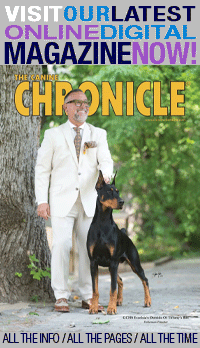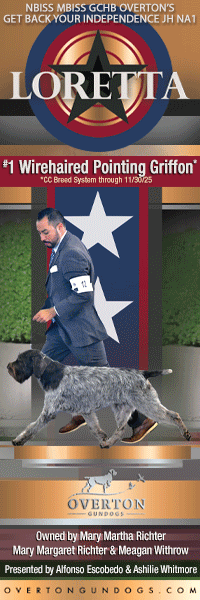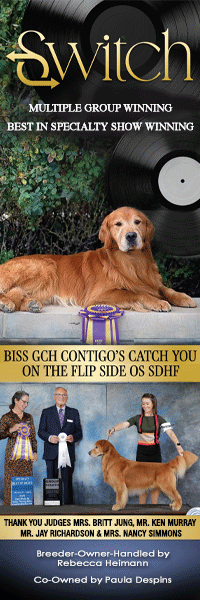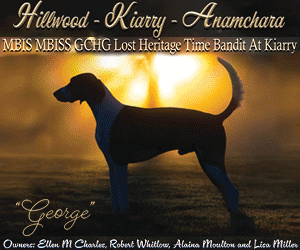The Great Dane
Click here to read the complete article
A Colorful History
By Amy Fernandez
 Few breeds exemplify the gestalt of purebred dogs like the Great Dane. Equally magnificent and adorable, that amazing dichotomy can only result from a rich, varied history. Its size, majestic presence, benevolent expression, and endearing temperament confirm that background. But nothing reflects the breed’s heritage better than its candybox of colors and markings.
Few breeds exemplify the gestalt of purebred dogs like the Great Dane. Equally magnificent and adorable, that amazing dichotomy can only result from a rich, varied history. Its size, majestic presence, benevolent expression, and endearing temperament confirm that background. But nothing reflects the breed’s heritage better than its candybox of colors and markings.
The Great Dane standard is notable for its range of acceptable colors and its precise, descriptive clarification of each one. AKC, FCI, and Kennel Club versions vary somewhat but they all acknowledge six distinct colors cultivated within the breed – brindle, fawn, blue, black, harlequin, and mantle.
The Great Dane’s cornucopia of color genes long predates its emergence as a documented purebred. The mastiff/greyhound combination represents one of the oldest and most enduring selective breeding projects in the history of Canis familiaris. This blend of strength, speed, size, endurance, and courage became the basis for countless breeds documented during Classical times. That was true for many early purebred prototypes. However, most of them fell off the map as Europe fragmented after the fall of Rome. The Dane’s forerunners were an exception. Collectively termed the alaunt, its primary forms and uses were documented throughout the middle ages in hunting treatise such as Livre de Chasse. Paraphrasing this definitive source of medieval purebred development in 1905, Watson confirms that Dane type was well-established by 1400, but far from the only popular variation on that theme. “Author Gaston Phoebus describes three principal types – one resembling a strong headed Greyhound, a short-faced butcher’s dog, the ancestor of our baiting breeds, and a powerful hunting mastiff of Great Dane construction.”
Versatility and utility ensured its perpetuation and popularity, but like most working dog history, Dane development didn’t merit much historical notice until the Scientific Revolution swept through Europe in the eighteenth century. Ambitious naturalists began cataloging every damn thing, including a bounty of regional mastiff/greyhound breeds. At that point, Germany certainly had no monopoly on this design, but it was unquestionably a prolific source of Dane progenitors. Countless numbers of them undoubtedly came and went without any acknowledgement. Even so, they left their mark on this big eclectic gene pool.
That doesn’t imply that these strains didn’t evolve into recognizable regional types. Some that were frequently mentioned included the Grosse Bullenbeisesser, also called the Bärenbeisser, or Deutsche Dogge. Equally popular first and second generation crossbred Mastiffs were known as Englische Dogge. Another type predominant in southern Germany was the Ulmer Doggem distinguished by its massive size and black and white coloration. In northern and central German states the Dänische Dogge was common; a bit smaller and lighter, its typical colors included fawn, Isabella and blue. Another variation, a rough, surly, no nonsense design known interchangeably as the Saupacker/Saurude or Hatzrüdem was typically brindle. Some of these strains scored higher from an aesthetic standpoint, but the bottom line for all of them was functionality, not appearance. Politics triggered the first big tilt in that arrangement.
Otto von Bismarck (1815–1898), Germany’s Iron Chancellor, stepped up to the plate in 1862. His catch phrase “blood and iron” exemplified his determination to forge an industrial and military behemoth from Germany’s federation of states and principalities. By the time Bismarck’s united German empire emerged in 1870, his Great Dane pack was a media sensation, frequently because of their outrageous antics that instantly revised the tone of many icy diplomatic encounters. This ongoing public attention sent Dane popularity to new heights, especially blues, the color of Bismark’s favorite dog, Tyras. Germany’s national fixation with the Dane is traceable to Bismarck but his influence may have extended far beyond that superficial impact.
Blue Danes lost ground after Bismarck left the stage, but the Dane’s overall popularity didn’t skip a beat. Germany didn’t initiate the momentum but as “the crossroads of Europe” it inevitably became a focal point of the emerging purebred movement. National pride ensured that traditional indigenous breeds were well-represented at early German shows and Danes topped that list from the start. It debuted as a showdog at the Hamburg show in July 1863. The entry of 15 was equally represented by Dänische Doggen and Ulmer Doggen. This sort of détente typified Great Dane exhibition for the next decade as clubs experimented with classifications based on weight, color and regional type.
Some historical sources cite the1876 Hamburg show as the first instance of a judge taking the initiative to combine the varieties into one class. There was a logical basis for that decision, but that approach became increasingly unworkable as breed competition regularly began exceeding one hundred. Regional politics obviously came into play, but that wasn’t all. Maybe at home these strains were separately cultivated, but the rest of the world was industriously mixing them into an increasingly weird mess.
 Dane popularity catalyzed Germany’s ascendancy in the purebred world. That commenced with the infamous 1878 Berlin meeting to resolve the spiraling chaos of Great Dane popularity. Dr. Bodinus, Director of the Berlin Zoological Gardens, headed the conference. Prominent participants included Eduard Colmar Messter (1840-1913) the megarich German industrialist who owned the era’s largest and most influential Dane kennel. Messter’s massive breeding program definitely qualified as industrial production. It yielded historically significant Danes including Nero I, Else I, Nero II, Nero V, Mentor, Mentor II, Sultan I, Sultan VI, Minka, Cora, and the celebrated Flora. Possibly the most controversial committee member was Max Hartenstein, a militant German nationalist and owner of the famed Plavia kennel in Saxony. Hartenstein was a relative newcomer to the breed, acquiring his first Dane 1874, technically a Wurttembergischer Hartrude. Hartenstein’s more famous protégé Josef Berta eventually inherited his Dane kennel and continued his mentor’s crusade for German breeds. All seven participants came to the table with unassailable credentials. But from an international perspective there was one problem, they were exclusively German.
Dane popularity catalyzed Germany’s ascendancy in the purebred world. That commenced with the infamous 1878 Berlin meeting to resolve the spiraling chaos of Great Dane popularity. Dr. Bodinus, Director of the Berlin Zoological Gardens, headed the conference. Prominent participants included Eduard Colmar Messter (1840-1913) the megarich German industrialist who owned the era’s largest and most influential Dane kennel. Messter’s massive breeding program definitely qualified as industrial production. It yielded historically significant Danes including Nero I, Else I, Nero II, Nero V, Mentor, Mentor II, Sultan I, Sultan VI, Minka, Cora, and the celebrated Flora. Possibly the most controversial committee member was Max Hartenstein, a militant German nationalist and owner of the famed Plavia kennel in Saxony. Hartenstein was a relative newcomer to the breed, acquiring his first Dane 1874, technically a Wurttembergischer Hartrude. Hartenstein’s more famous protégé Josef Berta eventually inherited his Dane kennel and continued his mentor’s crusade for German breeds. All seven participants came to the table with unassailable credentials. But from an international perspective there was one problem, they were exclusively German.
Their primary focus was standardizing the customary purebred hallmarks: size, head type, outline, proportion, etc. which by then stretched pretty wide. They got around to that a few years later. They made a few other decisions during that meeting and those triggered a firestorm of international rancor. Along with their self-declared ownership of the breed; they announced that, in the future, it would be known as Deutsche Dogge.
By then, the Great Dane was far more than a national product, it was a worldwide phenomenon. Most notably, England had a substantial stake in the game. Perhaps they couldn’t match Germany’s numbers, but they had the history albeit often difficult to untangle from the Mastiff.
Writing in 1912, Dr. Morrell Mackenzie stated in Great Danes Past and Present that the name Great Dane could be traced to 1775 in Britain. “There can be no possible doubt that the Great Dane has existed in England and Ireland for the last 150 years, that it has been known by that name, and that it is not, as many people would have us believe, a new breed to England introduced after the Franco-German war.” Classes at British shows were first offered for Danes at the Alexandra Palace in January 1879, Birmingham first offered Dane classes in 1883 and by 1885 a Great Dane specialty attracted 60 entries.
England’s first Dane club was founded in 1882 and a second club emerged in 1886. The Kennel Club admitted the breed to the stud book in 1883. Ironically, Sultan II, an import from the gargantuan Meester kennel, became the first British champion in 1884. Most significantly, several influential British bloodlines were established during these years, beginning with Violet Horsfall’s Redgraves kennel. Regardless of this, England had no intention of answering to anyone when it came to purebred jurisdiction. Despite vociferous German objections, Great Dane became the breed’s official name in the English Stud Book in 1894. From there, it was onward and upward for the British Dane fancy. “The remarkable advances made by Great Danes during the last few years …A large entry at the Ladies Kennel Association was followed by one of 116 at Richmond. …Danes are going ahead rapidly, threatening to hold a numerical supremacy of all other large breeds.” (The Kennel, Sept. 1910).
Lamenting Germany’s increasing emphasis on Dane color, Our Dogs editor Theo Marples captured the prevailing British sentiments at that time calling it “an innovation with which a large portion of the fraternity has recently been seized…It is a German introduction since color is a cardinal point in connection with the breed in the Fatherland; but then the dog is found in greater perfection there than in England, speaking generally. The breed is however making rapid strides now, if this color fad does not retard its legitimate progress.” It’s quite possible Britain would have had the final say in Dane evolution. But a couple of things happened to revise the odds. England’s cropping ban followed by its drastic quarantine restrictions had a tremendous negative impact on Dane progress in that country.
Meanwhile, in typically German fashion, breeders persevered to establish their concept of the breed, specifically that ubiquitous challenge of melding multiple strains into a unified type. Arguably, from a sociological standpoint their approach to the task reflected Bismarck’s concurrent unification of Germany. But it certainly ran counter to established convention. The established Kennel Club protocol was to identify an ideal type and ruthlessly select against everything else. It works; therefore few fanciers contemplate the collateral damage. However, plenty of good stuff disappears in the wake of this slash and burn process.
Although these strains shared a genetic heritage, breeders had perfected distinctive, recognizable types within that framework. By then, they were more than potential purebreds. They symbolized regional pride. From the start, Germany made a decisive effort to preserve this genetic heritage. The official Deutsche Dogge standard published in 1880 divided Danes into brindle, solid color, and spotted with patches of black or gray.
In her meticulously researched account of Dane evolution, Time Traveler, Jill Evans tracked this steady effort to define and untangle the breed’s many color genes, a task comparable to coordinating paisley, tartan, and polka dots. A couple of significant factors contributed to the ultimate success of this gargantuan job. Obviously, this was only possible within the context of documented breeding, which was an equally slow uphill battle.
On January, 12 1888 the Deutsche Doggen Club became Germany’s first specialty club. The German kennel world’s unique arrangement became a crucial component of this effort. At that point, most kennel clubs fought an uphill battle to encourage consistent registration. Fanciers weren’t accustomed to taking orders and most attempts to implement and enforce rules met with belligerent disregard. Arguably, many German breeders would have opted to ignore the organization’s strict breeding regulations and intensive culling requirements without the intensive grassroots supervision built into this system.
Emerging discoveries about genetic inheritance also added an element of scientific credibility to the DDC’s visionary approach to Dane breeding. From a practical breeding standpoint, this information simply confirmed knowledge previously gleaned through observation and experience. But it became an essential component to successfully promoting codified color breeding practices.
Volume I of the studbook published 1897 documented breeding dating back to 1883.
It listed:
221 brindle
146 harlequin
81 fawn
61 blue
25 black
Color was an ongoing focus of attention, but it never overshadowed the breed’s overall progress. As Evans notes in Time Traveler, studbook records also documented some unusual color variations like fawnequin because these dogs that were deemed important despite their atypical colors. Sacrificing type for the sake of color would have defeated the purpose entirely.
Gradually breed-ers became more contentious about documenting their work, making it easier to calculate hereditary influences and reliably identify carriers. Even so, records revealed many cases of genetically impossible combinations. Partly, this was due to personal recordkeeping variations. Primarily, it stemmed from the enormous backlog of undocumented contributors to the gene pool. And thanks to recurring wartime upheavals, that problem seemed never-ending.
Those wartime upheavals also jacked up the flow of Great Dane stock to our shores. Like everywhere else, the breed caught on quickly in America, and Germany’s influence prevailed from the start. From a historical standpoint that’s surprising. Plenty of breeds arrived here with similarly established traditions and, in most cases, those rulebooks were immediately tossed out of the window. Americans are simply wired to resist authority, but not in this case.
The Great Dane also became a rare exception to AKC’s standard deference to Kennel Club authority. Except for siding with England’s decision about the breed’s name, (which may explain why the Dane avoided the anti-German sentiments that undermined many breeds during WWI and WWII) Germany, not England, guided its American evolution from the start.
German imports were the mainstay of the breed’s American foundation starting with Prince, the first documented import, in 1857. Exactly three decades later a German brindle bitch, Juno, earned the breed’s first AKC championship, the same year that Danes became one of the first breeds recorded in AKC’s studbook.
 The forerunner of Great Dane Club of America, the German Mastiff Club was founded May 3, 1899 in Chicago. It became AKC’s fourth specialty club, represented by none other than Gustav Muss Arnolt. Outspoken and opinionated as a judge, journalist, and AKC director, Muss Arnolt is best remembered for his artistic contributions to purebred dogs. As a second generation Dane fancier with strong ties to Germany, he exerted a tremendous influence on the breed’s development here.
The forerunner of Great Dane Club of America, the German Mastiff Club was founded May 3, 1899 in Chicago. It became AKC’s fourth specialty club, represented by none other than Gustav Muss Arnolt. Outspoken and opinionated as a judge, journalist, and AKC director, Muss Arnolt is best remembered for his artistic contributions to purebred dogs. As a second generation Dane fancier with strong ties to Germany, he exerted a tremendous influence on the breed’s development here.
Early American kennels generally imported, bred and campaigned all colors. As in Germany, the foundation gene pool featured quite a range of colors like blue brindle and white slate. For instance, in 1910 the first Dane specialty was held in Woodside, Queens. From an entry of 80, Westminster superintendent James Mortimer chose the German import, Helios von Wurttemberg, a fawn dog with no mask.
Revisions to the AKC standard reflected Germany’s ongoing progress to define and perfect all the breed’s inherent colors. The 1892 standard allowed generous variations on those basic solid, brindle, and spotted themes. By 1900, those parameters were considerably stricter, which certainly indicates the breed’s progress.
Both here and in Germany, strict adherence to the color breeding code commenced after World War II. The color description in the 1944 AKC standard was taken verbatim from the German standard. However, evidence confirms that Germany’s color breeding philosophy was entrenched long before that time. By the 1930s legendary kennels were established throughout the country such as Garricrest, Walnut Hall, and Brae Tarn. Most of them had narrowed their focus to specialize in one or two colors, an approach that would characterize Dane breeding in the future.
By the 1950s adherence to color breeding guidelines became a hallmark of quality breeding and color mixing was tantamount to sacrilege. GDCA policies certainly fostered these practices, such as requiring five generations of pure color pedigrees for futurity-nominated litters. In theory, this approach was logical and valuable, but a “one-stop shopping” selection process only worked if each color family possessed all the necessary components of ideal type. And they didn’t. Ongoing frustration prompted a few brave souls like J. Council Parker and Hugo Gamboa to buck the system and cross colors in order to impart elegance, introduce soundness, and improve head type.
Possibly, the kennel most closely associated with color mixing is Honey Hollow, founded in 1947 by former silent film star Lina Basquette. Flamboyant and outspoken, Basquette’s advocacy of color crossing scandalized the Dane fancy. But it was hard to argue with success. Ch. Honey Hollow Stormi Rudio, a fawn out of black breeding, won eight Best in Shows and the 1959 Westminster Working group. She handled her Danes to wins that redefined the breed’s competitive potential. Her top winning black, Ch Honey Hollow Great Donner, was shown to 45 group wins and four Best in Shows. She also handled Ch. Big Kim of Belladane to top Dane from 1966 through 1969, winning 90 groups, 24 BIS, and the Quaker Oats award in 1968. She showed his son, Ch Heideres Kolyer Kimbayh, to 28 BIS and his greatgranddaughter, Ch. C & B’s Special K Gribbon to her record as the breed’s top winner with 29 BIS.
These experiments yielded some breakthrough dogs, but overall, breeders remained committed to the standard color breeding protocols for understandable reasons.
The downside of cross color experiments was a blast from the past. Harlebrin, tricolors, merlequin, and fawn mantle harlequins graced the countless generations of recessive carriers and made for interesting surprises.
Like many other aspects of breeding, the advent of genotyping is revising longstanding practices. The traditional color breeding protocols may soon be replaced by DNA clearances to identify recessive color genes lurking in bloodlines. That possibility will certainly simplify many aspects of Dane breeding and remove most of the guesswork from pedigree research as well as the deliberation and calculation as well as imaginative planning that went hand in hand with that effort. Dane breeding may seem overly rigid, but it certainly fostered a mindful approach to purebred reproduction. Nothing confirms that practice better than the fact that, unlike many breeds, none of its inherent colors were sacrificed during its transition to purebred status.
Short URL: https://caninechronicle.com/?p=79811
Comments are closed











